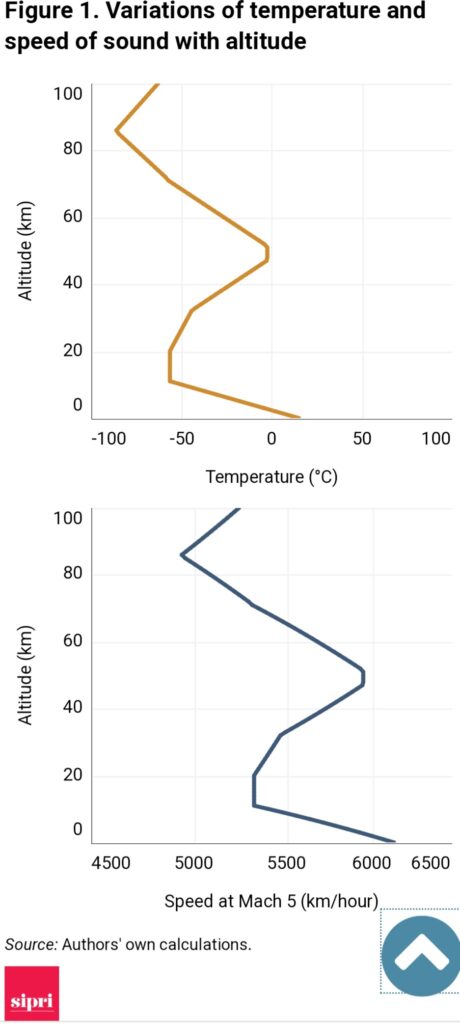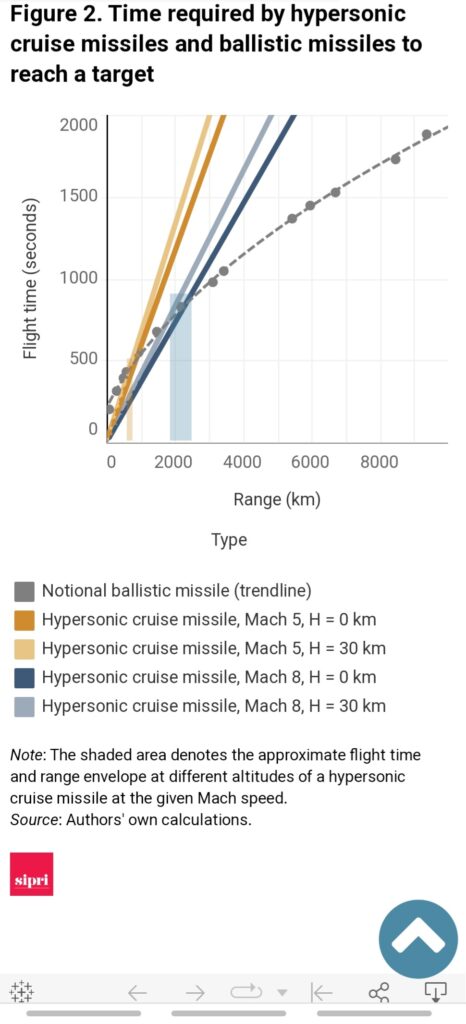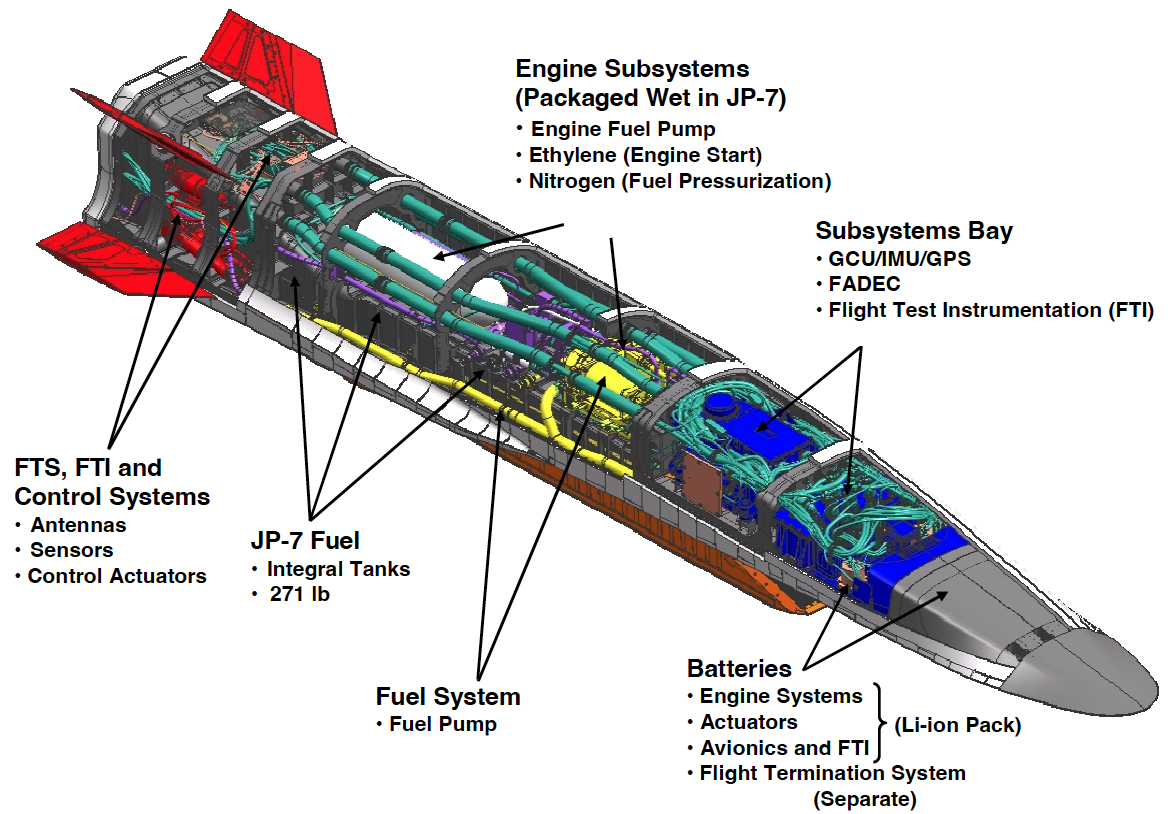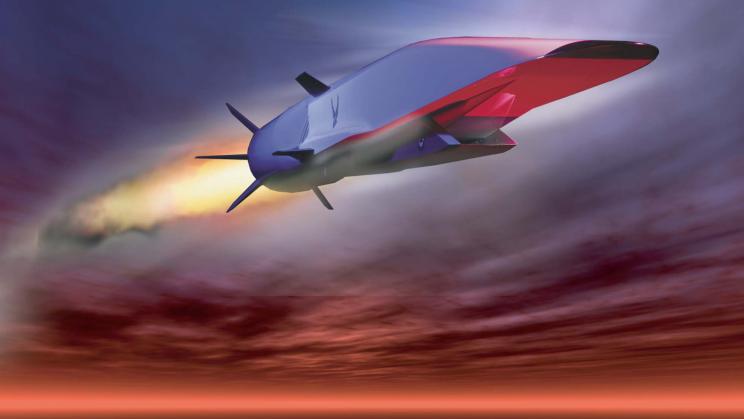By Kolja Brockmann and Dr Markus Schiller
Over the past weeks and months, ‘hypersonic missiles’ have again made headlines in global defence news. On 5 and 11 January, North Korea performed test flights of what it claims is a ‘hypersonic missile’. The announcement, the released pictures and the flight path suggest North Korea tested a rotational symmetric glide vehicle atop a rocket booster that performed pull-up and cross-range manoeuvres during its flights. However, many analysts have argued that in this case, the label of manoeuvrable re-entry vehicle would be more appropriate. In September 2020, North Korea tested what it called its first ‘hypersonic missile’, a ballistic missile booster with a wedge-shaped hypersonic glide vehicle. Another example where the term ‘hypersonic missile’ was used by media outlets was in August 2020, when China was reported to have tested a ‘hypersonic glider’.
These examples demonstrate how confusing—and potentially distorting—the term ‘hypersonic’ is when it is applied to a whole range of missile systems by a range of different actors. Some of the news coverage of these events also indicated a lack of understanding of the different types of ‘hypersonic missiles’, the role of their speed and manoeuvring capabilities, the physics behind them, and their military capabilities and missions. This SIPRI Topical Backgrounder seeks to improve the understanding of hypersonic speed, the nature of hypersonic missile systems, as well as their key subsystems and technologies. Improving the understanding among policymakers and journalists could help inform political and public discourses and identify opportunities for applying targeted non-proliferation and arms control measures to reduce the risks associated with them.
Understanding hypersonic speed
The term ‘hypersonic speed’ is widely defined as any speed beyond Mach 5, meaning five times faster than the speed of sound. This threshold is used to define a subset of air vehicles because a range of physical effects start becoming a significant engineering challenge at that speed. Specifically, the object endures a massive heat flux when it flies through dense layers of the earth’s atmosphere at hypersonic speeds. This and other physical effects make developing aerial vehicles for hypersonic flight particularly difficult and costly. However, there are also some problems linked to the definition of ‘hypersonic speed’, and with that, part of the definition of ‘hypersonic missiles’.
First, defining hypersonic speed as anything beyond Mach 5 actually results in a variation of the object’s speed, depending on its altitude. The speed of sound, which defines the speed of Mach 1, depends not only on the chemical composition of the gas that the sound is moving through (in this case, the air in the earth’s atmosphere) but also on its temperature. The most common standard model of the earth’s atmosphere, the US Standard Atmosphere, shows a significant change of temperature with altitude. This results in a different measurement of what the speed—in kilometres per hour—of a missile moving with Mach 5 is, simply depending on the altitude that the missile is flying at (see figure1).

There is also another factor to add to this variation. Since the Mach number strongly depends on the surrounding gas that the object is moving through, using a Mach number for definitions becomes more and more difficult once the surrounding gas gets thinner and thinner—and disappears completely at higher altitudes. While scientists and engineers agree that it still makes sense to talk about Mach numbers at altitudes around 30 km—which weather balloons and special aeroplanes can reach—there certainly is not enough atmosphere at an altitude of 300 km—where satellites are already orbiting the earth. Due to the nature of the earth’s atmosphere, which becomes exponentially thinner with altitude, it is difficult to agree upon a clear altitude limit where Mach numbers should still be used as a measurement of speed, and with that, where hypersonic missiles can sensibly be defined by stating that such missiles travel faster than Mach 5.
Distinguishing hypersonic weapon systems
Hypersonic speed is often pointed to as one of the key factors—if not the key factor—that set ‘hypersonic’ missiles apart from other missiles. However, the speed of ballistic missiles (predating the current hype around hypersonic missiles by almost a century) in many cases far exceeds that of today’s ‘hypersonic missiles’. The ancestor of ballistic missiles, Germany’s A-4 (which later became commonly known as the V-2) was first launched in the 1940s. During ascent, it could reach a speed greater than Mach 5 (although only for a brief period) and could do so again momentarily on its way back down. But, no one would claim that the V-2 was a hypersonic missile. In a similar vein, should one apply this label to modern intercontinental ballistic missiles that reach speeds beyond Mach 20 at ascent and re-entry?
Certainly not, and there are other characteristics commonly cited when defining ‘hypersonic missiles’. However, while a combination of defining characteristics is increasingly adopted among experts, hypersonic missiles are often not well understood within public discussions in politics and the media. Wikipedia, a common starting point for those new to the topic, defines ‘hypersonic flight’ as ‘flight through the atmosphere below about 90 km at speeds ranging between Mach 5–10, a speed where dissociation of air begins to become significant and high heat loads exist.’ However, a V-2 missile would be classified as a hypersonic missile under this definition. The US-based Missile Defense Advocacy Alliance states that ‘hypersonic weapons refer to weapons that travel faster than Mach 5 (~3800mph) and have the capability to maneuver during the entire flight.’ An article published by the Russian International Affairs Council states that ‘there are two major defining characteristics [that] are prerequisite[s] to label a weapon “hypersonic”: Speed exceeding Mach 5 [and the] capability to make maneuvers (both vertical and horizontal) while traveling at this speed inside the atmosphere.’ Many ballistic missiles fall outside of the definition since they do not meet these prerequisites.
Given the speed and manoeuvrability characteristics, hypersonic weapons are further subdivided into two different types of missile systems: hypersonic cruise missiles (HCMs) and hypersonic glide vehicles (HGVs). HCMs keep a constant hypersonic speed (and usually altitude) and are powered over the entire course of their flight. In contrast, HGVs are usually launched on tops of ballistic missiles (often referred to as a boost-glide system) and then glide back through the atmosphere to their target at hypersonic speeds. There are also hybrid cases that do not match either of these categories, but exploring these is beyond the scope of this backgrounder.
It is worth considering the speeds of hypersonic missiles (in this case HCMs) and comparing them with those of ballistic missiles (which may or may not carry an HGV as a re-entry vehicle) to get an idea of how long it takes for both types to reach targets at different distances (see figure 2).

The distance a ballistic missile can fly depends on the speed which it accelerates—the faster it flies, the further it goes, just like throwing a rock. In contrast, HCMs travel at an (almost) constant speed, which is independent of how far away their target is. As illustrated by figure 2, ballistic missiles reach their target quicker than hypersonic missiles at distances beyond roughly 600–800 km for HCMs constantly travelling at Mach 5 (depending on the altitude). Conversely, hypersonic missiles reach their targets faster at ranges of more than roughly 1900–2500 km for HCMs constantly travelling at Mach 8, which is currently seen as the maximum speed they may travel using current technology. This means that HCMs usually take longer than ballistic missiles to reach distant targets. As HGVs are usually carried by ballistic missiles, the time they require to reach a target depends on the trajectory the booster is launched at, the distance covered, and the manoeuvres performed while gliding towards the target.
Speed, manoeuvrability and the characteristics of each of these types of hypersonic missile systems make them more or less suitable for specific military missions and present challenges for missile defence systems. This also influences their possible impact on strategic stability. However, reaching the desired performance characteristics often implied when talking about HGVs and HCMs requires overcoming a range of significant technical challenges.
Subsystems and technology challenges for hypersonic glide vehicles
Any HGV, whether it carries a conventional, nuclear, or no weapon payload, is designed so it can independently perform the necessary manoeuvres to fly precisely into a given target. Sensors and computational capabilities are required to enable the vehicle to maintain a certain degree of autonomy. Consequently, an HGV requires many of the same (or at least similar) basic subsystems a ballistic missile requires, with the exception of the propulsion system. Because an HGV is launched on a rocket booster, it is usually intended to glide towards its target and does not need a main engine.
The main subsystems of an HGV are:
- a guidance and control system;
- a lightweight airframe (with sufficient thermal shielding);
- the payload (for some limited missions, an HGV could potentially rely on the kinetic energy of the impact alone).
As with ballistic missile systems, developing and integrating these subsystems is very difficult. For example, the guidance and control system needs a power source, a computer, sensors, and actuators—such as aerodynamic control surfaces or small cold gas thrusters that enable performing manoeuvres. As one adds the cables, bolts, screws, nuts and elements where these components are affixed, the total weight and the required space increase. There also needs to be enough room to carry the actual payload in most cases. As a result, HGVs are usually neither small nor light, which significantly impacts the capabilities of the overall system and the necessary trade-offs between some of its capabilities.
Any HGV is intended to move through thicker layers of the atmosphere at a very high speed, thus creating a huge heat load and ionizing the air around it. This heat load puts a huge strain on the airframe, which should also be able to withstand any stresses generated by manoeuvres that the HGV is to execute. Also, the plasma cloud generated by the HGV moving at hypersonic speed makes it very hard for any type of sensor to sense anything, let alone to identify and lock onto a target. The HGV, therefore, must know exactly where it is without any help from the outside, thus requiring very precise inertial sensors, among others. The technological challenges of these requirements are comparable to those of a spacecraft designed to re-enter the earth’s atmosphere. But they are even more demanding due to the stricter size and weight limits of HGVs as well as additional requirements derived from their military role.
Designing, building and operating a reliable HGV presents many challenges, including access to technology, high development costs and testing requirements.
Subsystems and technology challenges for hypersonic cruise missiles
The basic requirements for HCMs are similar to those of HGVs, with the exception that the speeds may be lower (even top speeds of Mach 8 have not been convincingly demonstrated yet). In addition, HCMs carry propulsion systems, which have to be highly sophisticated to maintain hypersonic speeds over significant durations. Currently, it seems that only some advanced ramjets and supersonic combustion ramjets (scramjets) are capable of meeting these requirements. Hypersonic propulsion using air-breathing engines over longer distances presents extreme technical challenges. So far, no state has deployed a missile system using a scramjet engine, but research, development and testing continue.
The same basic elements that are required for an HGV (albeit in a very different design) are also relevant for HCMs, with the addition of the propulsion system:
- a guidance and control system;
- a lightweight airframe (with sufficient thermal shielding);
- a highly efficient propulsion system (usually a scramjet);
- the payload.
Adding the propulsion element adds to the problems mentioned for HGVs, as is illustrated by the US X-51A ‘Waverider’ prototype (which would be an HCM). The X-51A was only designed to demonstrate scramjet operations for a few minutes of hypersonic flight without the capacity to carry a weapons payload. At more than 4 metres in length, the X-51A cruiser module was completely packed (see figure 3), with no extra room for a payload. This shows the severe limitations regarding weight and volume for any subsystem elements in HCMs.

Figure 3. A cutaway diagram of a X-51A’s subsystems packaging.
Source: Hank, J. M., Murphy, J. S. and Mutzman, R. C., ‘The X-51A Scramjet Engine Flight Demonstration Program’, 15th AIAA International Space Planes and Hypersonic Systems and Technologies Conference, May 2008, p. 7.
As with HGVs, many of the same technology requirements arise for HCMs. Heat loads may be comparable (depending on the mission), and sensors, as well as the guidance system, have to meet comparable requirements. The sophisticated technology required for a workable scramjet propulsion system is currently a major obstacle for HCM development efforts.
The capabilities of different states’ HGVs and HCMs, respectively, can vary significantly depending on the sophistication of the technology, design and engineering choices. Assessing and comparing the real capabilities of any such systems should thus go deeper than a capability to reach speeds greater than Mach 5 and a certain degree of manoeuvrability.
Conclusions
Returning to the reported hypersonic missile tests by North Korea, in both cases, enabling manoeuvrability appears to be one of the main objectives behind the apparent design choices. Therefore, merely describing these systems as ‘hypersonic missiles’ neither provides the necessary understanding of their actual speed, nor their manoeuvrability or the type of hypersonic weapon system they are. These examples are also a reminder that different degrees of manoeuvrability may be achieved using different types of re-entry or glide vehicles and that speed—and even manoeuvrability—are only two of the key characteristics of a missile system. As North Korea continues its intensive testing cycle, it is important to consider characteristics and types of systems and assess them for their capabilities and possible missions—beyond the ‘hypersonic’ label.
The excessive focus on ‘hypersonic missiles’, particularly in some popular media, paired with a lack of understanding of the limitations of this descriptor, has meant that discussions on the risks created and possible responses have sometimes overly focused on the threat of reduced response times, or impact on missile defences and other countermeasures. Questioning why certain actors—be they states or industry—adopt this terminology can help reveal motivations and vested interests in the hype around hypersonic missiles, i.e. to appear threatening or attract funding. More informed discussions have explored, for example, the potential impact of significant manoeuvring capabilities, including target ambiguity and the evasion of radars and other sensors. In the way that it is currently being used, the term ‘hypersonic’ often has little to no meaning and at the same time fuels competitive dynamics and a fear of missing out on the technology. Overcoming this lack of nuance could help put a brake on some of the competitive dynamics and hype-driven military spending. For example, the capabilities of some existing missiles often already provide the desired capabilities. Conversely, the advantages of future hypersonic missiles over other systems are sometimes exaggerated and come with a large price tag. Considering the technical and economic challenges of developing and deploying viable hypersonic weapon systems can help inform arms control and non-proliferation efforts addressing risks posed by hypersonic missiles.
ABOUT THE AUTHOR(S)

Kolja Brockmann is a Researcher in the SIPRI Dual-Use and Arms Trade Control programme.
Dr Markus Schiller (Germany) is an analyst at Munich-based consulting company ST Analytics.
Credits | SIPRI

